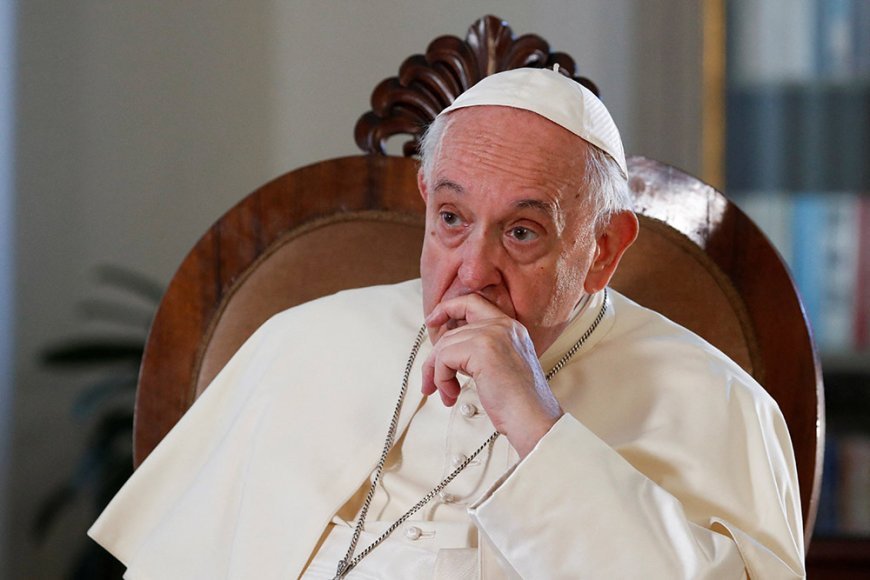In Three Coffins: How A Pope Is Buried
Following Pope Francis' death, attention now turns to the process that takes place in laying to rest a world leader with a stature akin to his.

On Monday, April 21, the world was left stunned by the death of Pope Francis, the 266th leader of the Roman Catholic Church.
The Vatican News confirmed that Pope Francis died at the age of 88, after battling double pneumonia for over one month. Cardinal Kevin Farrell, the Camerlengo of the Apostolic Chamber, confirmed that the Pope died at 7:35 a.m. on Easter Monday.
Following Pope Francis' death, attention now turns to the process that takes place in laying to rest a world leader with a stature akin to his. When a Pope dies, the world doesn't just lose a religious figure—it witnesses the end of an era.
The death of the Bishop of Rome, the spiritual leader of over a billion Catholics, sets off a chain of ritual, tradition, and ceremony that stretches back centuries. But how exactly does the Vatican bury a Pope? Here's a full breakdown of the ancient process that blends solemnity, symbolism, and spectacle.
1. First Comes the Confirmation of Death
The death of a Pope is never taken lightly, and it is not officially recognised until it is confirmed by the Camerlengo, or Chamberlain, of the Holy Roman Church, as was the case here. This person acts as the temporary administrator of the Vatican between popes, and their first job when a pope dies is to verify the death.

The late Pope Francis during a past address. /MIDLAND REPORTER-TELEGRAM
Traditionally, the Camerlengo would tap the Pope's forehead three times with a small silver hammer while calling his baptismal name. Today, that part is mostly symbolic and not physically done, but the role still involves officially declaring the Pope deceased and taking control of the Apostolic Palace.
The Pope’s Fisherman’s Ring—a signet used to seal official documents—is then destroyed in front of a group of cardinals to prevent forgery. This moment is one of the clearest symbols that the Pope’s rule has come to a full stop.
2. The Body Lies in State
After the death is confirmed, preparations begin for a public farewell. The Pope's body is usually transferred to St. Peter’s Basilica, where it lies in state for several days. This is when thousands—sometimes millions—of pilgrims, citizens, and tourists pour into Vatican City to pay their respects.
The Pope’s body is dressed in traditional papal vestments: a white cassock, red mozzetta (cape), red papal shoes, and a white mitre (bishop’s hat). He is displayed inside the basilica on a raised platform, with candles surrounding him and the Swiss Guard standing vigil.
There’s no casket at this stage—just the body, the vestments, and the immense reverence of the crowd. This phase usually lasts for about 3 to 5 days, giving the public a chance to grieve and reflect.
3. The Funeral Mass: A Global Spectacle
The Pope's funeral typically takes place between 4 and 6 days after death, allowing enough time for dignitaries and global leaders to travel to Rome. It is held in St. Peter’s Square and is led by the Dean of the College of Cardinals.
The event is huge, often drawing hundreds of thousands of mourners. Heads of state, royalty, religious leaders, and countless pilgrims converge for a high Mass, broadcast around the world.
One key part of the funeral is the homily, which reflects on the Pope’s life, legacy, and faith. While it’s deeply spiritual, the funeral also serves as a global goodbye. It is a mix of prayers, incense, chant, and choreography that would rival any state-level sendoff.
4. The Triple Coffin Tradition
Once the Mass concludes, the burial preparations begin. This is where centuries of tradition show up in full force. The Pope isn’t just buried in one coffin—he gets three.
First: The Cypress Wood Coffin
The innermost coffin is made of cypress wood. It is simple, unvarnished, and symbolises humility and the Pope’s humanity. Before it is sealed, a few key items are placed inside:
-
A copy of the Rogito — a document summarising the Pope’s life and accomplishments.
-
Medals and coins minted during his papacy.
-
A white silk veil over the face.
-
A rosary in his hands.
The cypress coffin is closed and wrapped with red silk cords, then sealed with wax.
Second: The Lead Coffin
This coffin is more heavy-duty. It's made of lead to preserve the remains and protect them from the elements. It is soldered shut and stamped with the Pope’s name, his papal coat of arms, and the dates of his papacy.
The cypress coffin is placed inside it, and it is sealed like a time capsule.
Third: The Elm or Oak Outer Coffin
The third and final layer is usually made of elm or oak, a noble wood that symbolises the dignity of the papal office. This is the outer coffin that the public sees during the burial. Once closed, it is secured with golden nails.
This three-tiered approach—wood, lead, and wood again—is unique to popes and other extremely high-ranking Catholic figures.
5. The Burial Site: St. Peter’s Basilica
Most popes are buried in the Vatican Grottoes beneath St. Peter’s Basilica. These underground chambers hold tombs of dozens of previous popes and martyrs, including St. Peter himself.
The coffin is carried into the grotto in a solemn procession. It’s accompanied by chants, candles, and cardinals. Sometimes the burial is public, sometimes private—depending on the Pope’s wishes and the Vatican’s call.
If the Pope specifically asked for a different resting place, like Pope John Paul II did (who was originally buried in the grotto but later moved upstairs to a chapel), those wishes are honoured.
Once the coffin is lowered into the tomb, it’s sealed with a marble slab bearing the Pope’s name and dates of his life. And just like that, the earthly journey of the Pope comes to a close.
6. Mourning Period and Papal Vacancy
After the funeral, the Church enters a formal mourning period. It’s called the novemdiales—a nine-day cycle of mourning and prayer. Each day, a special Mass is held for the deceased Pope, focusing on different aspects of his service.
During this time, Vatican operations continue but without major decisions. The Church is officially in a state of sede vacante—“the seat is vacant.” The Camerlengo continues managing day-to-day affairs, but major theological or administrative moves are paused.
7. Preparing for the Next Pope
The Pope's burial isn't just about honouring the past—it also sets the stage for the future. Once the novemdiales end, the focus shifts to the conclave—the secretive process where cardinals from around the world gather to elect a new Pope.
No one campaigns. No press briefings. The cardinals are locked inside the Sistine Chapel until they reach a decision, marked by the iconic white smoke from a chimney. But none of that begins until the burial is complete and the mourning period has ended.
Why It Still Matters in the 21st Century
For some, this whole thing might seem like an anachronism—why so much ritual for one man? But for Catholics, the death and burial of a Pope isn’t just about a leader dying. It’s about preserving a continuous, sacred line that stretches back 2,000 years to Saint Peter himself.
The whole process is designed to do three things:
-
Honour the life and service of the Pope.
-
Give the global Church a space to grieve.
-
Signal the transition to a new spiritual era.
Even in a hyper-modern world of digital funerals and livestreamed goodbyes, the Vatican’s ancient rituals still captivate global audiences and offer a rare moment of unified reflection.
Wrapping Up
The burial of a Pope isn’t just about laying a body to rest. It’s about legacy, continuity, and ceremony on a level no other world leader commands. It reminds the world that—even in 2025—there are still some traditions that carry weight, command reverence, and bridge the gap between history and the present day.







